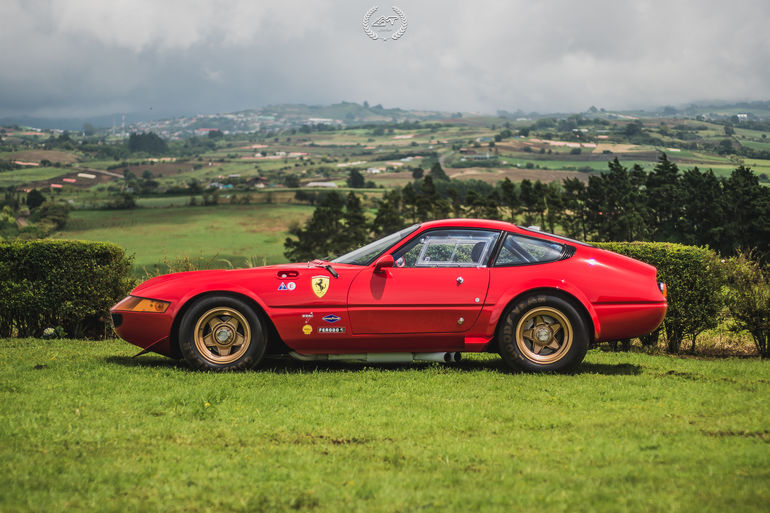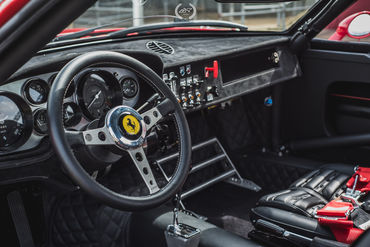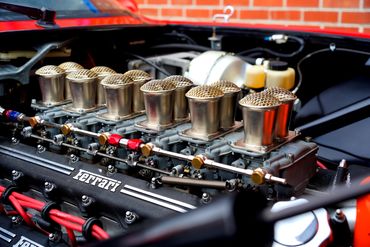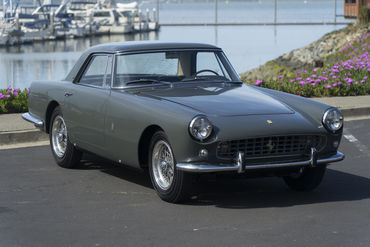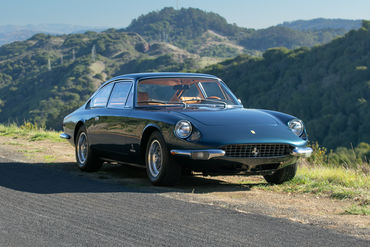Sold
SOLD 08/22
1971 Ferrari
365 GTB/4 Daytona Competition Specification
Beautifully Executed Conversion to Group 4 Competizione Specification. All Alloy Body, A/C, Power Steering, FIA Papers. Fresh Cosmetic and Mechanical Restoration, and Eligible For Premier Events.
- VIN13383
- Exterior ColorRosso Corsa
- Interior ColorBlack Leather
- Mileage4219 Kilometers (TMU)
- Engine4.4 Liter Quad-Cam V12
- Transmission5-Speed Transaxle
- StatusSold
- StockFJ2350
Description
1971 Ferrari 365 GTB/4 Daytona Competition Specification
s/n 13383
Rosso Corso with Black Leather Interior
The arrival of the V12 flagship 365 GTB/4 “Daytona” stunned patrons of the 1968 Paris Auto Show. Unofficially named the Daytona by the press, commemorating the recent 1-2-3 finish by Ferrari at 24 hours of Daytona, the media name rightfully conveyed the inspirational Ferrari win, and cemented their brand as a world leader. The Daytona featured a landmark Pininfarina body design, capturing a crisp, modern look with reverence to classic GT cars of the past. Given the mid-engine surge from Lamborghini and other sports car manufacturers, the Daytona might have been considered dated, but performance figures obliterated any doubts in 1971 when Dan Gurney and Brock Yates won the rigorous Cannonball Run in their Daytona at an average speed of 80.1 mph across 3,000 miles of America.
Technical specifications included a 4.4 liter quad cam Colombo V12 engine producing over 350 hp and rear-mounted 5-speed transaxle, delivering optimal weight distribution. With independent suspension, disc brakes at all four corners and superb weight balance, the Daytona was extremely fast (174mph top speed) and quick (0-60 in 5.3 sec). Just 1284 Daytonas were produced before yielding to the mid-engine Berlinetta Boxer. And while press and public awareness was centered around the premier road car performance, after 500 units had been produced, FIA homologation for International Group 4 Special Grand Touring allowed Ferrari to prepare a limited number of Competizione versions for customer use. This series included fabricating an all-alloy body similar to the thin alloy units prepared for the 1969 Le Mans 24 Hours. The factory cars also included a roll cage, wider rear tires, flared fender, front fender stabilizer blades (which improved high-speed front-end aerodynamics), side exit exhaust, and a cold airbox to aid air flow to the Weber carburetors. By 1972 the cars were competing to a high level of success, particularly with privateers through the 1970s adding several subsequent modifications and improvements to these specialized cars.
This uniquely prepared competition build was originally constructed as a factory road car finished in white with black interior. The car was delivered new to an Italian client in 1971. Later sold to Japan, the car was imported to England in 2004 where the owner at that time embarked on a detailed and documented construction to Series 1 competition Group 4 specifications. During this construction, Series 1 modifications began by carefully removing the factory body shell and installing an FIA roll cage. Expert fabricator Steve MacFarlane fabricated a stunning 1.2 mm thickness alloy body enveloping the factory per original Competizione specifications. The wheel openings were flared to allow the correctly sized front and rear magnesium wheel and tire combination. The headlight configuration was also fabricated to competition standards with correct Plexiglas covers. Plexiglas sliding side windows and a plexiglass rear window were also installed per original specifications. A competition outside fuel filler cap was configured to the rear, directly feeding a large capacity FIA fuel cell located in the trunk of the car.
The engine was rebuilt with high compression pistons and standard camshaft specifications and updated with Roelofs competition exhaust manifolds. The Weber carburetors were fitted with competition inlet trumpets and a hand formed cold air intake plenum positioned above the radiator. Tim Adams Racing Engines dyno tested the engine. The resulting power makes for a very exciting car on the track, while remaining very tractable for road use.
After completion of the initial build, the car was shipped to Portugal where it was race-prepared by Lorenzini Autosports of Lisbon and granted FIA HTP. The car was track tested at Estoril before being stored away with less than 3 hours logged on the motor. This Daytona was then further updated including fresh red paint with racing livery, and engine upgrades. At this time, larger rear fender flares were added as well as induction cowl venting, updating the car to reflect some of the best attributes of the second and third series Competizione cars.
Most importantly, the accompanying FIA papers confirm the chassis to be of correct period specifications, correct adjustable coil platform suspension, fitted with a roll bar, six correct Weber 40 DCN 21 carburetors, using an electric fuel pump, and dry sump lubrication. A large capacity ATL fuel cell (with FIA compliance) occupies a large portion of the trunk, and an approved fire suppression system is properly fitted to the car with dashboard activation easily at hand. Additionally, the car is equipped with a power steering unit, modern twin electric cooling fans, and dual-mode air conditioning, all of which are welcome upgrades particularly on long distance or summer driving events.
In 2019 the car was sold through Fantasy Junction to the current and consigning owner. Work performed on the car under current ownership includes the addition of a power brake booster, the addition of Cadmium plated trumpets, and recent service by Patrick Ottis including re-jetting the carburetors to sea level.
Today this Daytona presents as a stunning example representative of factory Competizione cars. Every detail of the original factory construction including the rare, exposed headlight configuration, thin front fender high-speed stability blades, deep-angle front spoiler, and flared fender construction are all beautifully configured as part of the hand formed alloy body. The all-alloy body is exceptionally well-made with excellent build quality including correctly finished exposed rivet construction with beautiful glossy red paint covering the alloy panels. The finishes are beautifully prepared and correctly outfitted with proper features such as a front tow hook, correct recessed exterior electrical cut off, polished aluminum fuel filler, and chrome finished side marker lights.
The doors, hood, and trunk open and close with excellent panel fit, itself a remarkable achievement given the aluminum construction and hand fitting required for these panels. Emblems, lighting, and various trim are further in excellent condition, with both front and rear valances cleanly shaped in the body due to the absence of bumper trim. The side glass has been replaced with correctly fabricated lightweight Plexiglas sliding units and proper trim supporting the perimeter mounts. The wicked and pounce-like stance is enhanced by competition inspired satin gold Cromodora wheels, which are in excellent condition. The wider rear wheel and tire configuration (10.4” x 15”) and correct front wheel and tire sized Goodyear racing tires complete the competition appearance of this remarkably constructed car.
The interior is a stunning combination of original Ferrari Daytona features including beautifully finished correct leather seating with perforated inserts, a correctly replicated racing dashboard, and exceptional interior accents. The dashboard has a well-composed combination of original style instruments and competition style toggle switches, coupled with an exposed gated shifter, correct Ferrari steering wheel, modern Simpson competition seat belts, and a foot-rest bar appropriate for fortunate passenger bracing when cornering at speed. The factory round dashboard vents offer cold A/C to the cabin via a two-stage toggle switch on the central panel. The general interior presentation throughout is one of high quality, combining important safety upgrades, originality, and historically correct Competizione features.
The engine and engine compartment further exemplify the thoughtful combination of original features and finishes, blended with racing details and uniquely fabricated parts. The engine has been professionally rebuilt and restored using correct finishes, proper hardware, and assorted Ferrari components. The six dual-throat Weber carburetors are beautifully presented with Cadmium finished velocity stacks, surrounded by a hand-formed aluminum forced-air intake tray, which delivers a nice contrast to the clean and honest representations of the factory crackle black Ferrari cam covers and custom racing exhaust. Further finish details include proper wiring, correct hoses, and an assortment of specially made parts, which have been either hand built or refined from original specifications. The underside is further evidence of a clean and professionally prepared car that has been properly addressed throughout the build and maintained under previous and current ownership. The chassis shows no visual evidence of damage or structural compromise, presenting the same level of confidence, construction, and excellence afforded throughout the build.
Opening the lightweight alloy doors via the delicate factory door handle, the leather trimmed Daytona seat await just beyond a slight lift over the padded FIA side protection bar. A specific starting procedure to the electric fuel pump and ignition releases a V12 fury into a deep and throaty idle as the engine warms to operating temperatures. The engine climbs the revs, warming slowly as it comes to temp. Ready to engage, the throttle responds with a crisp, raspy voice. The light clutch takes up smoothly without shuddering and the gearbox works very well, both cold and warm with excellent synchros. The suspension is taut and responsive, with a bit more stiffness than a typical road car, allowing for more aggressive cornering and power transfer when exiting corners. The brakes, now benefiting from power-assist, should be warmed up for competition use, but even under general driving conditions are quite impressive. Acceleration is similar to a road going Daytona until pushed into the higher revs where the engine delivers a welcomed boost of power that drivers will easily enjoy leveraging under more spirited driving conditions. The car is offered with select records, FIA papers, a car cover, and spare Plexiglass headlight covers. Having benefited from both high-quality mechanical and cosmetic preparation, the car remains impressive, but, as always, we recommend the next owner engage a qualified racing specialty shop to perform a careful review and inspection of all mechanical components prior to spirited competition use.
This truly exceptional competition Daytona has been constructed by attentive experts with careful regard to Competizione specifications and appropriate modern racing updates to meet FIA requirements. Sold with FIA papers, this Competition Specification Daytona is ready to bring a new owner both street and event driving pleasure at a fraction of the cost of a multi-million-dollar period construction example.
The above vehicle information is complete and accurate to the best of our knowledge at the time it is posted to this website. Corrections or additional information is always appreciated. All advertised prices exclude government fees and taxes, any finance charges, any dealer document preparation charge, and any emission testing charge. Vehicles are subject to prior sale. All advertised to be true but not guaranteed. We assume no liability for errors or omissions.
Inquire About This Car
Fantasy Junction • 510-653-7555 • 1145 Park Ave, Emeryville, CA 94608
